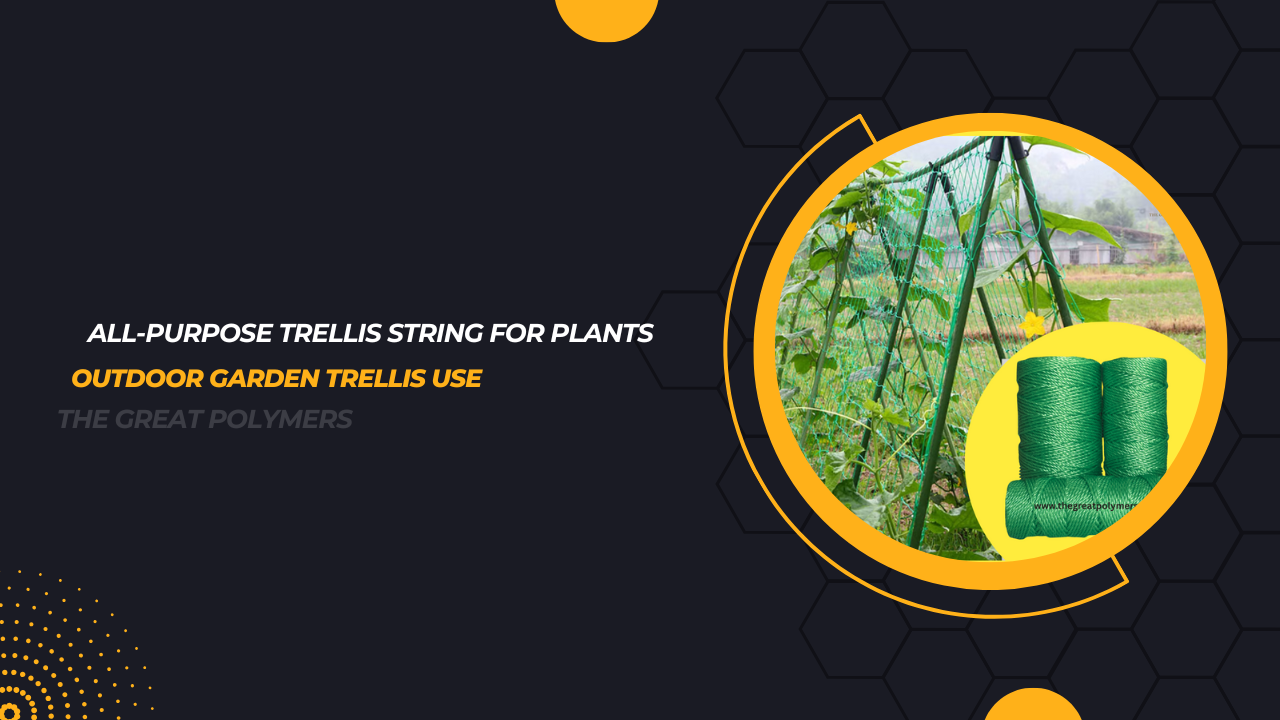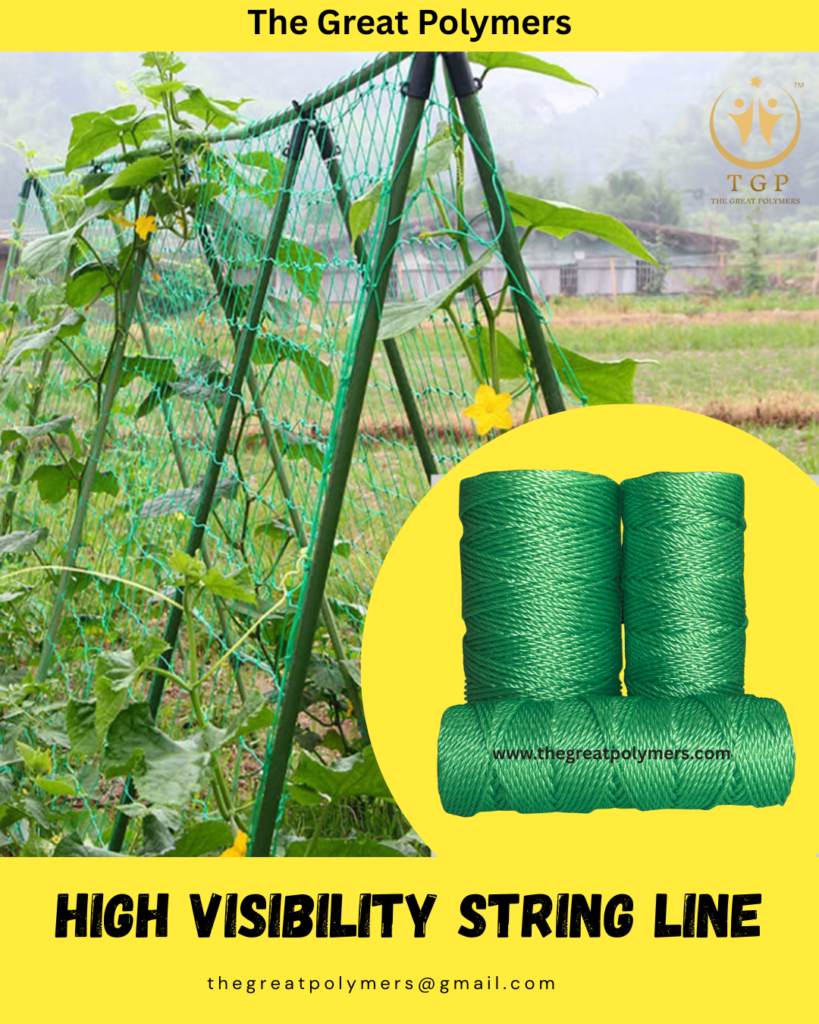Gardening has always been a blend of science and art. Whether you’re a backyard hobbyist, an urban balcony gardener, or a professional farmer, one thing remains true: plant support is essential for healthy growth and maximum yield. Among the many tools available, all-purpose trellis string stands out as a versatile, reliable, and affordable solution.
In this comprehensive guide, we’ll dive deep into the benefits, uses, and best practices of trellis string for tomatoes, peppers, and cucumbers—three of the most popular climbing or vining crops. By the end, you’ll understand why this simple product can transform your gardening game.
1. Why Trellis Support Matters in Gardening
Plants like tomatoes, peppers, and cucumbers naturally grow tall or spread wide, often requiring structural support to prevent bending, breaking, or sprawling across the ground. Without support, these plants can:
- Become prone to diseases due to poor airflow.
- Rot quickly when fruits touch the soil.
- Produce lower yields because of tangled stems and blocked sunlight.
- Attract more pests and fungal issues.
By using a trellis string system, you create vertical growth opportunities that not only maximize space but also improve plant health and productivity.
2. What Is Trellis String?
Trellis string is a strong, lightweight cord specifically designed for plant support. Unlike regular ropes or household strings, it is UV-resistant, durable, and soft enough not to damage delicate stems. It can be made from materials such as:
- Polypropylene (PP) – lightweight, weather-resistant, and reusable.
- Nylon – strong and flexible, often used for heavy crops.
- Natural fibers – like jute or cotton, biodegradable but less durable outdoors.
Gardeners love it because it is:
- Easy to install.
- Cost-effective.
- Adaptable to multiple trellis systems.
3. Advantages of Using Trellis String
Using all-purpose trellis string offers multiple benefits for gardeners of all levels:
- Maximizes space – Vertical growth allows more plants in smaller areas.
- Healthier plants – Better air circulation reduces mildew and fungus.
- Higher yields – Plants put energy into fruiting rather than sprawling.
- Cleaner produce – Fruits hang freely, avoiding soil contact.
- Easier harvesting – No need to search through tangled vines.
- Eco-friendly option – Many trellis strings are reusable or biodegradable.
4. How to Use Trellis String for Tomatoes
Tomatoes are one of the most common plants requiring strong support. Depending on the variety—indeterminate or determinate—your trellising method may differ.
Steps to Trellis Tomatoes with String:
- Install overhead support – Use a horizontal pole, beam, or greenhouse frame.
- Attach trellis string – Tie the string securely above the plant, allowing it to dangle down.
- Anchor at the base – Tie the other end loosely to the base of the plant or stake it in the soil.
- Train the vine – Wrap the main stem gently around the string as it grows.
- Prune side shoots – For indeterminate tomatoes, remove suckers to keep growth vertical.
Tip: Use nylon trellis string for heavier tomato varieties as it withstands more weight.
5. Trellis String for Peppers
While peppers don’t climb as aggressively as tomatoes or cucumbers, they still benefit from support because heavy fruits often bend or snap branches.
Best Practices:
- Tie a string from an overhead support down to the pepper stem.
- Use soft clips or garden ties to avoid damaging stems.
- Train peppers upright to prevent fruit from touching the soil.
With trellis string, your pepper plants remain upright, healthy, and more productive.
6. Trellis String for Cucumbers
Cucumbers are natural climbers and thrive when provided with vertical support. Left unsupported, they sprawl across the ground, increasing the risk of powdery mildew, rot, and pest infestations.
How to Use Trellis String for Cucumbers:
- Install a vertical or A-frame trellis.
- Tie the trellis string from the top frame to the ground.
- Train cucumber vines to wrap around the string as they grow.
- Space strings about 6–8 inches apart for maximum coverage.
This method keeps cucumbers straight, clean, and easy to harvest.
7. Setting Up a Trellis String System in Your Garden
Whether you have a backyard garden or greenhouse, setting up a trellis system is simple.
Materials Needed:
- Trellis string (nylon or polypropylene recommended).
- Support structure (poles, beams, or greenhouse frames).
- Clips, ties, or hooks for securing plants.
Step-by-Step Setup:
- Build a sturdy frame – Wooden, bamboo, or metal poles work well.
- Run a horizontal bar – This will serve as the main anchor point.
- Attach trellis strings – Hang them down from the bar, spaced according to plant type.
- Secure plants – Use clips or soft knots to guide plants as they grow.
- Maintain regularly – Adjust strings as plants gain height and prune as needed.
8. Choosing the Best Trellis String for Your Needs
When shopping for trellis string, consider:
- Strength – Can it handle heavy crops like tomatoes?
- Durability – Will it last an entire season outdoors?
- Material – Synthetic strings last longer; natural fibers are eco-friendly.
- Thickness – Thin strings are discreet but may cut stems; thicker strings provide better support.
- Budget – Look for cost-effective options if you plan large-scale gardening.
For most gardeners, UV-resistant polypropylene trellis string strikes the perfect balance of strength, longevity, and affordability.
9. Common Mistakes to Avoid
Even with the right trellis string, mistakes can reduce effectiveness:
- Tying too tightly – Can damage or cut stems.
- Using weak string – May snap under weight of fruits.
- Neglecting pruning – Leads to overcrowding and reduced yields.
- Improper spacing – Too close causes tangling, too wide leaves gaps.
- Waiting too long – Plants should be trained early for best results.
10. Maintenance and Longevity of Trellis String
To maximize value, maintain and reuse trellis string whenever possible:
- Clean after each season – Wash synthetic strings to remove dirt and pathogens.
- Check for wear – Replace frayed or weakened strings before reusing.
- Store properly – Keep in a dry, cool place to extend life.
- Rotate crops – Avoid reusing string on the same plant type without cleaning to prevent disease spread.
11. DIY Alternatives to Trellis String
While commercial trellis string is best, you can improvise with:
- Twine or jute rope – Affordable but less durable.
- Fishing line – Strong but may cut into stems.
- Clothesline or cord – Works but often too thick.
However, for long-term success, investing in proper trellis string designed for gardening is highly recommended.
12. Cost-Effectiveness and Value
Compared to metal cages or wooden trellises, trellis string is extremely cost-effective. A single roll can support dozens of plants for an entire season. For commercial growers, it reduces setup costs while maintaining high yields.
13. Expert Tips for Maximizing Results
- Always start trellising early in the season.
- Use clips instead of knots to avoid stem damage.
- Combine trellis string with drip irrigation for healthier plants.
- Choose varieties suited for vertical growth for best results.
- Rotate strings between tomatoes, peppers, and cucumbers to optimize use.
Conclusion
Using all-purpose trellis string for tomatoes, peppers, and cucumbers is one of the smartest investments a gardener can make. Not only does it save space and improve plant health, but it also ensures higher yields, cleaner produce, and easier harvesting.
Whether you’re tending a small home garden or managing a large greenhouse, trellis string provides versatility, affordability, and reliability. By choosing the right material, setting up a strong system, and maintaining it properly, you can take your gardening results to the next level.
If you want thriving, upright, and productive plants, trellis string is the ultimate support system you need this season.
FAQs & Answers
Q1: What length of trellis string is ideal for a standard garden row?
A: Typically, a 50–100 ft roll covers a 10–20 ft garden row, depending on how frequently you tie and secure plants. Measure your row length and plan spacing to determine the optimal amount.
Q2: Is this trellis string safe for delicate stems?
A: Absolutely! The soft but sturdy polypropylene cord grips vines without penetrating or slicing into tender stems—minimizing damage while offering reliable support.
Q3: Can I reuse the trellis string next season?
A: Yes! The durable, weather-resistant design lets you harvest, clean, and store the cord for reuse, saving both cost and materials.
Q4: Can I use the string with other climbing plants like beans or peas?
A: Certainly. The versatile design adapts to various climbing or vining plants, including beans, peas, melons, and more—just adjust the tying method to fit each species.
Q5: How do I tie the string to avoid constricting plant growth?
A: Use loose loops or simple knots, leaving a bit of slack to accommodate plant expansion. Check periodically and loosen ties if you see stem indentation.
Q6: Is UV resistance important in a trellis string?
A: Yes. UV-resistant materials prevent rapid degradation from sun exposure, ensuring the string stays strong and reliable throughout the season—even in full sunshine.
Q7: How do I remove and store the string at season’s end?
A: Simply cut vines free, unwind the string carefully, shake off debris, and coil it neatly. Store it in a dry location to preserve flexibility and longevity.
Q8: What gauge or thickness is best for heavy tomato plants?
A: A mid-weight, 2–3 mm thickness balances flexibility and strength—thin enough for gentle ties, yet strong enough to hold heavy fruit clusters securely.
Q9: Does the string come in different colors or materials?
A: While polypropylene is the standard for its strength and UV resistance, some brands may offer biodegradable alternatives or colored cords. Check product details or specs for options.
Q10: Can I use this string for vertical gardens or trellises?
A: Yes! It works great for vertical arrangements—tie portions of the string to supports, then guide plant stems to climb upward, maximizing vertical growth space.











Leave a reply